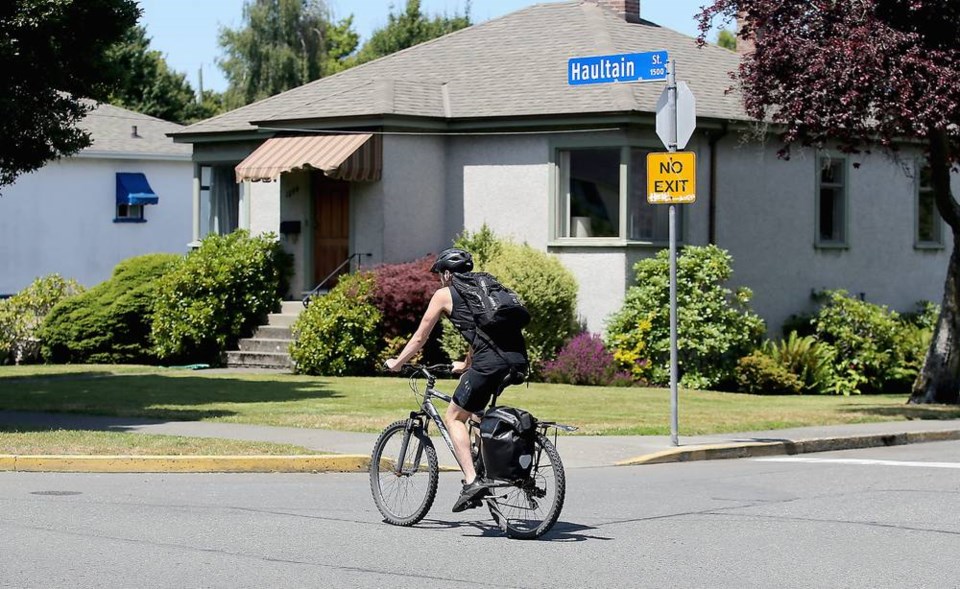A commentary by a teacher in the department of geography at the University of Victoria who chairs the Greater Victoria Placemaking Network.
In recent weeks, this newspaper published an opinion column and many letters critical of Victoria’s council-approved active transportation project along Richardson Street. A second column criticized some proposed bike routes in James Bay.
These correspondents strike a sadly familiar refrain of outrage and exaggeration: Bicycle-friendly projects are described as “disruptive, a disaster, a catastrophe.” It’s as if City Hall has cooked up some kind of two-wheeled COVID variant with no vaccine in sight.
Moreover, these complaints masquerading as informed opinion get the most basic facts wrong. What the city has planned on Richardson (and in James Bay, excepting Superior Street) are not “bike lanes.” These routes are designed differently than the painted or protected bike lanes downtown. What is planned for these residential streets are shared-use neighbourhood bikeways. That’s true for Montreal and Michigan streets in James Bay. And for newly approved routes in Oaklands and Fernwood.
This difference between bike lanes and bikeways is not just labels or language. It is a difference in physical design, cost and impact.
A much more apt comparison is more than 15 years old: The Haultain Street bikeway in Victoria, where car traffic is restricted at several intersections in one or both directions to reduce commuter traffic that cuts through residential areas. Traffic-calming helps create a neighbour-oriented street rather than one that serves commuters passing through.
Two years ago, Saanich designed Dean Street this way. It works very well by slowing traffic and ensuring safer, more pleasant walking and biking in the area.
Shared bikeways follow international design standards to reduce motor vehicle volumes and speeds with traffic circles, diverters and speed bumps.
Vancouver introduced these bikeway designs two decades ago, and continues to do so; dozens of these routes form a key part of Vancouver’s much-praised bicycle network.
The results are dramatic: commute trips by bike doubled to 6.1 per cent between 1996 and 2016. Ninety per cent of Vancouver residents now live within 400 metres of a comfortable bike route.
In one column, it’s claimed that Richardson was hastily approved in one weekend. Others complain about little or no consultation on various bike projects. That’s just wrong.
Each phase of Victoria’s active transport network has undergone extensive engagement and feedback. In 2017, after a full year of public engagement and detailed analysis, Richardson was selected as the preferred east-west route for the Fairfield area.
Fairfield Road was considered, but would have required the removal of most parking. As detailed designs were developed for Richardson and other Phase II routes, the city received 780 online surveys and 2,300 comments, held multiple community meetings, corridor tours and on-street events.
The Fairfield Gonzales Community Association highlighted the plan in newsletters, formed a task group, and made a presentation to council in favour of a neighbourhood bikeway design.
Far from being a “solution in search of a problem,” the approved Richardson design carefully suits its local context: Residential streets with seniors, families and children where high speeds are dangerous; neighbourhoods where short cuts by commuters should be discouraged; and a route with many driveways where painted or protected bike lanes aren’t feasible.
Evidently, most opponents of the city’s active transportation investments just don’t like change. They are put out that their driving routines may need to adjust.
Familiar roads are being altered to make room for and share with people making different transportation choices. This chorus of complaints rings loud in every North American city attempting to re-balance a transportation system that has overwhelmingly favoured automobile traffic and design for decades.
A couple of years back, proposed bike lanes on Cook Street created a storm of controversy. The main response was “put the bikes on Vancouver Street, it’s a better and quieter route.” Now the city has done just that, but the complaints remain.
Many say they are avid cyclists, suggesting that Richardson (or Vancouver) “works fine as it is, I’ve biked it for years, why change it?” But they should ask themselves: would they let their nine-year-old granddaughter or 13-year-old nephew ride a bike along one of those streets? Not very likely.
All-ages-and-abilities bike routes are designed not for today’s most intrepid cyclists, but for the more numerous people who are “interested in biking but too intimidated” by unsafe conditions.
Opposition to the proposed changes on Richardson and other efforts to advance active transportation in our city are, in the end, a strident defence of the status quo. It’s a view of the world from behind the windshield, a perch of privilege, of habit and entitlement (echoing attitudes in other social arenas, whether race, housing and employment opportunities).
Mostly, it’s a lack of imagination — a failure to see that our city can be better and streets safer for people who simply seek to get around in different and more sustainable ways.
- - -
Comment on this article by sending a letter to the editor: letters@timescolonist.com. Please include your contact information.



